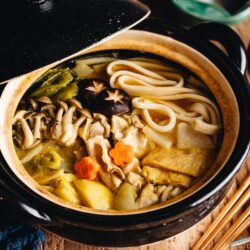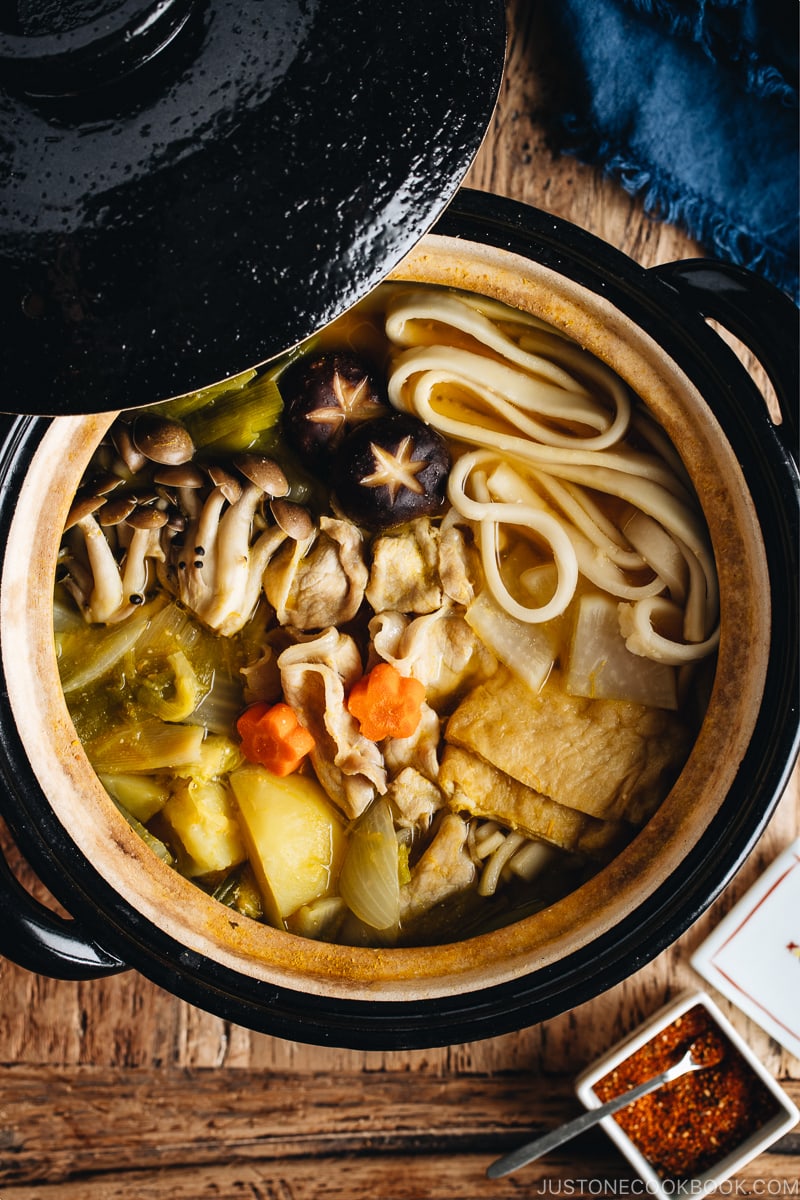
My family has visited Yamanashi prefecture a number of times. It’s in the proximity of Tokyo and Yokohama where my parents live, and the convenience brought us to a few different ryokan (Japanese-style inns) to enjoy delicious food and onsen (hot springs).
On each trip to Yamanashi, we get to enjoy the famous noodle soup called hoto (ほうとう, pronounced hō-tō). This hearty, homey, and rustic noodle soup is especially comforting in winter months. I can’t wait to share this delicious and versatile recipe with you!
What is Hoto?
Hoto (餺飥) is a miso-based noodle soup that originated in Yamanashi, Japan. This regional food of Yamanashi prefecture consists of vegetables (especially kabocha squash), meat, and thick wheat noodles in a dashi broth that is seasoned with local Koshu (甲州) or Shinshu (信州) miso.
The origin of hoto was due to shortages in local rice crops. The rice fields in Yamanashi were turned into wheat farming, and flour products like hoto noodles were invented to counter food scarcity.
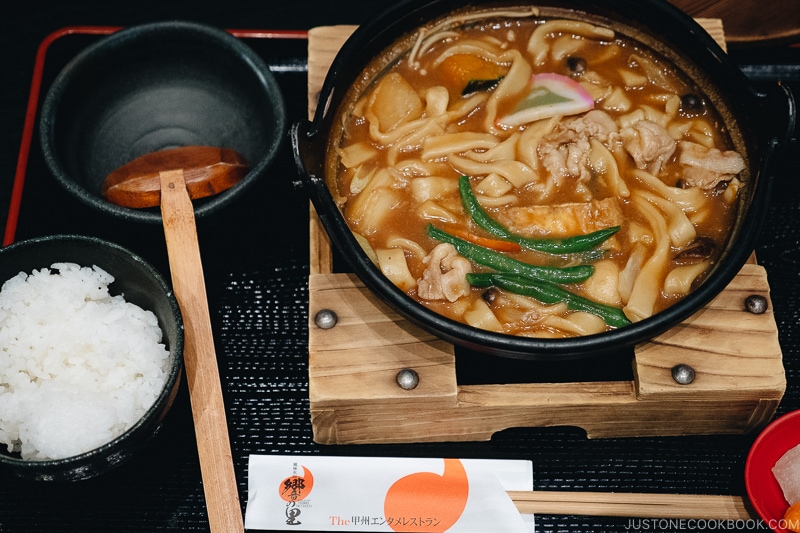
What are Hoto Noodles?
The flat, broad noodles in this regional soup are a bit different from udon noodles. The dough has a tougher texture and is not mixed with salt or left to sit. Hence, the noodles are more doughy and lack elasticity. It’s a lot more similar to dumplings than noodles. They don’t require parboiling before use; simply add to the pot with the rest of the ingredients.
Fresh hoto noodles are impossible to find outside of Yamanashi, so I recommend using frozen Sanuki udon noodles as a reasonable and convenient substitution. If you have time, try making hoto noodles from scratch with flour and water. It’s easier than you think! See the recipe end Notes for instructions.
Why You’ll Love This Recipe
- One-pot dish – Cook everything for this hot pot recipe in a donabe (Japanese earthenware pot), iron pot, or a heavy-bottomed soup pot.
- Seasonal ingredients – Substitute fresh, in-season vegetables for variety and great flavor.
- Flexible recipe – This homestyle dish works just fine with the ingredients that you have in the fridge.
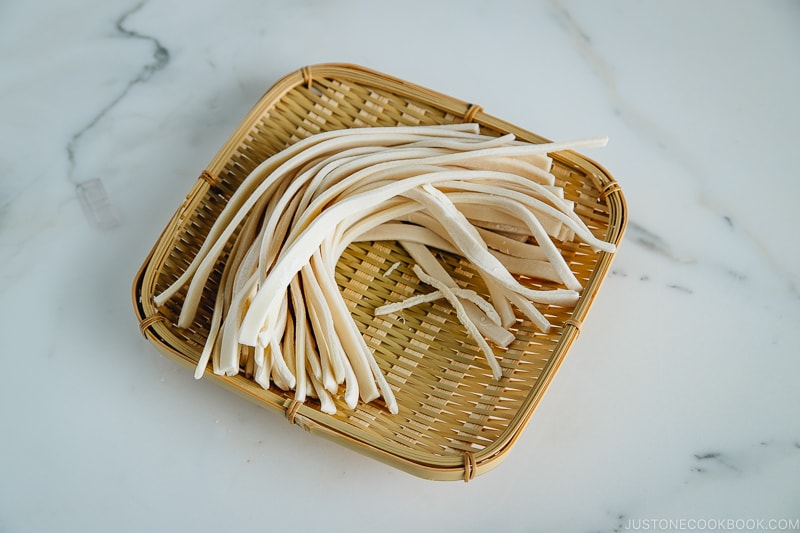
Ingredients for Hoto Noodle Soup
Here’s what I used for today’s recipe. Feel free to customize to your dietary preferences:
- thick wheat noodles – use frozen Sanuki udon or make homemade hoto noodles; see the end Notes for how to make them.
- sliced pork loin – or use the proteins of your choice like chicken or tofu.
- kabocha squash – a signature ingredient of hoto noodle soup, but feel free to use any in-season vegetables
- daikon radish
- carrot
- Yukon gold potato
- onion
- napa cabbage
- leek – or Tokyo negi (Japanese long green onion)
- shimeji mushrooms
- shiitake mushrooms
- aburaage (deep-fried tofu pouch) – or use crispy fried tofu puffs from an Asian grocery store
- shichimi togarashi (Japanese seven spice) – optional; for serving
For the miso-based broth
- kombu (dried kelp) and dried anchovies (iriko/niboshi) – the Japanese soup stock (dashi) for this dish is traditionally made with both kombu dashi and anchovy stock (iriko dashi), but feel free to use what you have on hand. Vegans/vegetarians can use kombu dashi, shiitake dashi, or vegan dashi (a combo of shiitake kombu stock).
- water – for the dashi
- miso, sake, mirin, and optional Diamond Crystal kosher salt – to season the broth

How To Make Hoto Noodle Soup
- Make the dashi. Add the water, kombu, and tea bag of cleaned anchovies to the soup pot. Cover and turn on the heat to low. Slowly bring to a near boil, then remove the kombu. Cook the anchovies for another 10 minutes, then remove them from the pot.
- Prepare the vegetables. Meanwhile, remove the seeds and cut the kabocha into cubes. Cut the peeled daikon into quarter circles. Cut the peeled carrot into rounds. Cut the peeled potato into small chunks. Slice the onion. Cut the napa cabbage leaves and leek into smaller pieces. Cut off the shimeji mushroom root ends and shiitake mushroom stems.
- Pour boiling water over the aburaage to remove the oil. Cut it into 4 pieces.
- Heat the dashi over medium heat. Add the tough vegetables first, such as the leeks, onion, daikon, bottom white part of the napa cabbage, potatoes, and kabocha.
- Once boiling, add the sliced pork loin. Add the sake and mirin and bring it to boil again.
- Add the remaining ingredients and the hoto noodles (uncooked).
- Bring it to a boil again; skim off the foam and scum for a clear broth and refined taste.
- Add the miso and simmer until the noodles and ingredients are cooked through, about 10–15 minutes.
- Adjust the flavor to taste with salt and more miso. Serve hot in individual bowls. Sprinkle with shichimi togarashi (Japanese seven spice) if you like it spicy.
In Yamanashi, hoto noodles are cooked and served in an iron pot. At home, I use my versatile donabe (Japanese earthenware pot) for this and other hot pot dishes. No donabe? You can certainly use any soup pots; heavy cast iron or clay pots are best.
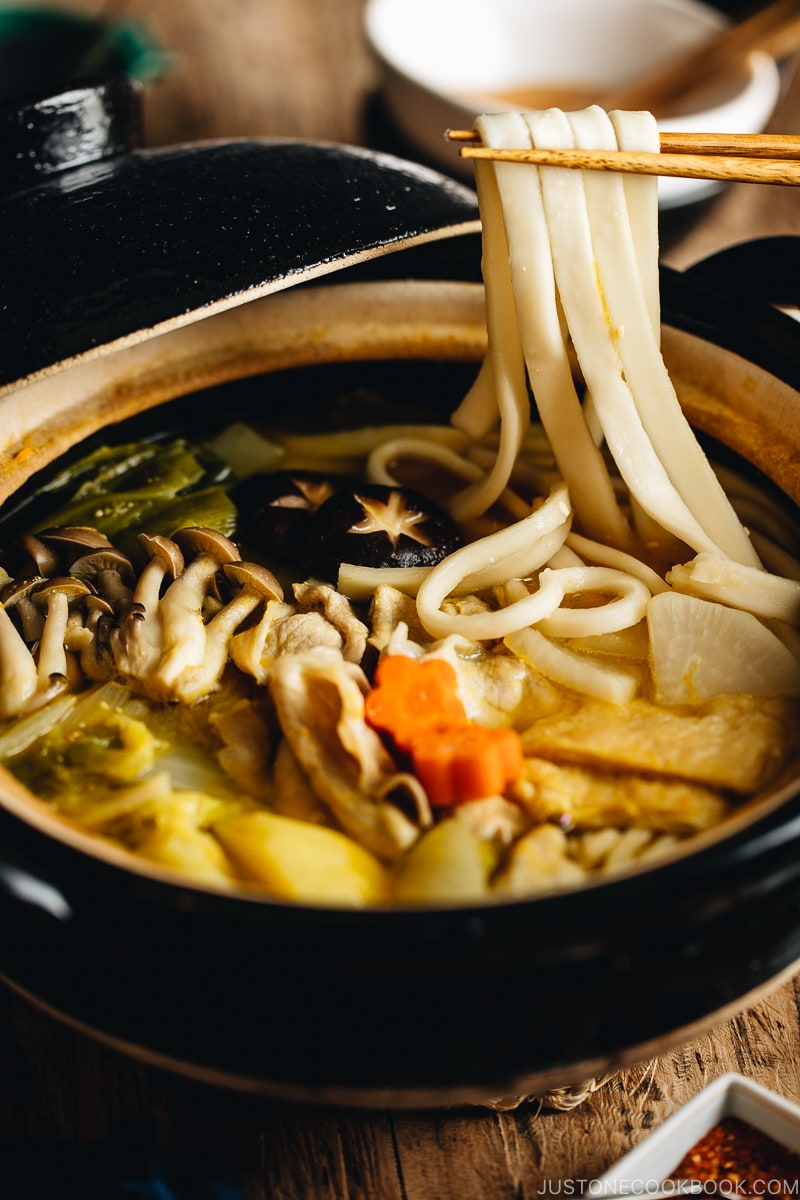
Mutenka Enjuku Koji Miso for Hoto Noodle Soup
The main flavor for the noodle soup is dashi made with anchovies and kombu, which is seasoned with local miso.
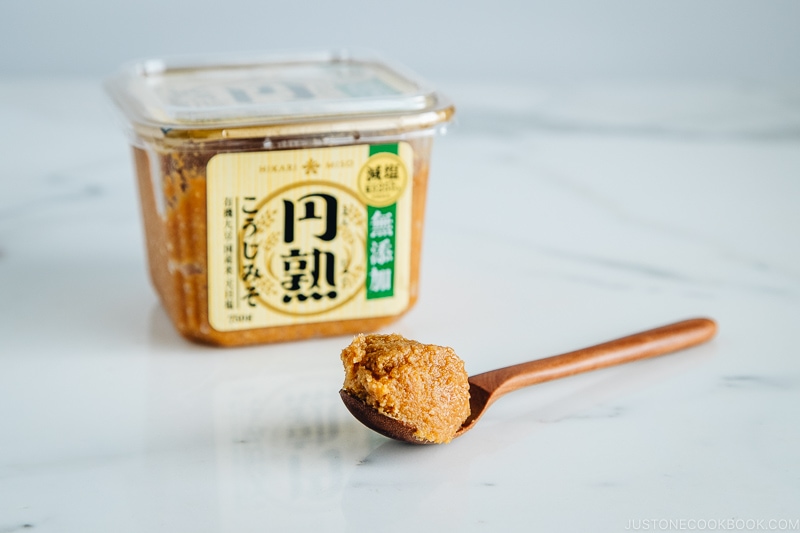
Mutenka Enjuku Koji Miso (with a green label) from Hikari Miso® contains 25% less sodium than Mutenka Enjuku Koji Miso. It still has a full flavor and umami yet no food additives or preservatives are used in this genuine koji miso. It is so delicious, and it’s one of my favorite miso to enjoy in all types of recipes that require miso.
If you already have miso in your fridge, you can definitely use it for the broth before you venture into other types of miso. You can read all about miso to be familiar with different types of miso.
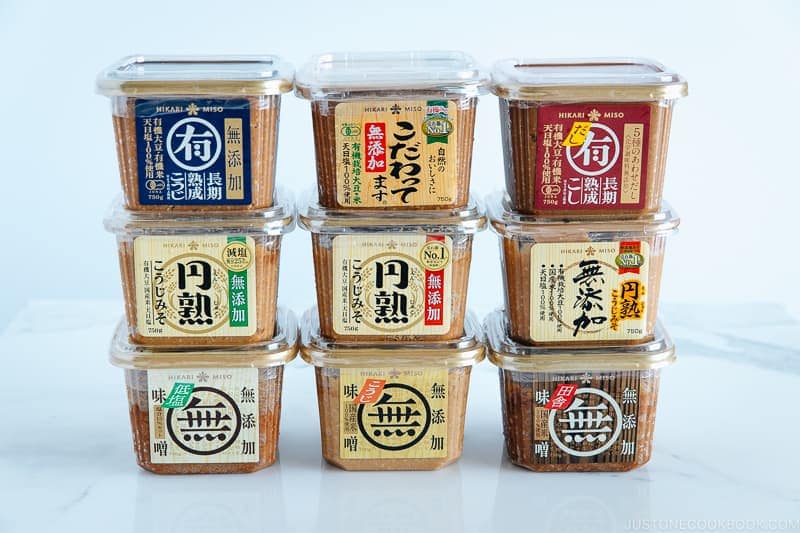
Where can I buy Hikari Miso®?
- Japanese grocery stores (Nijiya, Mitsuwa, Marukai, local mom-pop shops, etc)
- Asian grocery stores (including Chinese/Korean grocery stores)
I have been using all kinds of miso from Hikari Miso® for over a decade, and I enjoy the partnership with them. Thank you Hikari Miso® for sponsoring this post!
Explore Japan’s Regional Foods
Part of the fun of visiting Japan is the endless opportunity to try its multifaceted regional foods. And the great news is, you can recreate these flavors at home with the regional food recipes I’ve shared on Just One Cookbook.
I hope you enjoy making Hoto Noodle Soup, and if you have any recipe requests for Japan’s regional food, just leave a comment below!
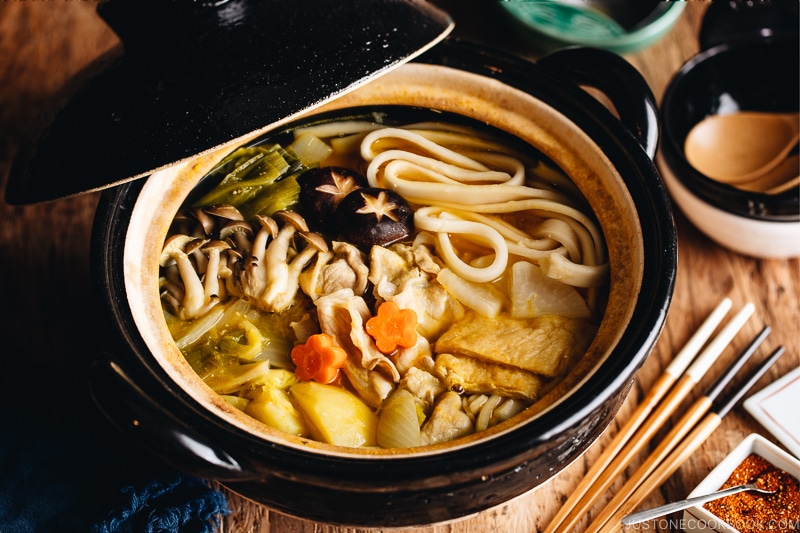
Wish to learn more about Japanese cooking? Sign up for our free newsletter to receive cooking tips & recipe updates! And stay in touch with me on Facebook, Pinterest, YouTube, and Instagram.
Hoto Noodle Soup
Ingredients
For the Dashi (anchovy + kombu)
- ¾ cup iriko/niboshi (boiled and dried anchovies) (skip for vegan/vegetarian)
- 1 piece kombu (dried kelp) (5 g; 1½ x 3½ inches, 4 x 9 cm per piece)
- 5 cups water
For the Ingredients
- ⅛ kabocha squash (6.3 oz, 180 g with seeds)
- 4.2 oz daikon radish (1½ inches, 3.8 cm)
- ⅓ carrot (4.2 oz, 120 g)
- 1 Yukon gold potato (5.2 oz, 148 g)
- ¼ onion (1.5 oz, 43 g)
- 2 leaves napa cabbage (6 oz, 170 g)
- ½ leek (or Tokyo negi/long green onion)
- ½ package shimeji (brown beech) mushrooms (1.8 oz, 50 g)
- 2 shiitake mushrooms
- 1 aburaage (deep-fried tofu pouch) (or you can buy crispy fried tofu puffs from an Asian grocery store; blanch them first to get rid of excess oil)
- 6 oz sliced pork loin
- 7.8 oz hoto noodles (uncooked) (or 18 oz, 500 g frozen sanuki udon noodles or make homemade hoto noodles; see Notes)
For the Seasonings
- 4 Tbsp sake
- 2 Tbsp mirin
- 5 Tbsp miso (or more, to taste)
- Diamond Crystal kosher salt (to taste)
To Serve
- shichimi togarashi (Japanese seven spice) (for a spicy kick)
Instructions
- Gather all the ingredients.
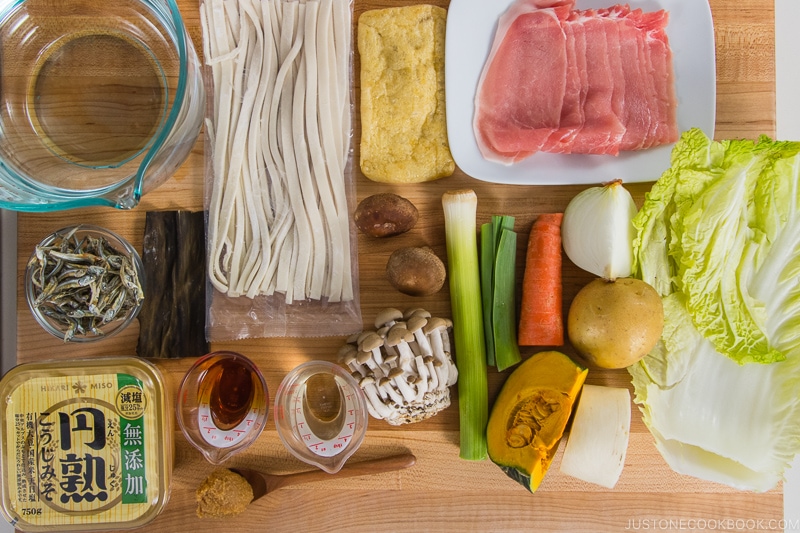
To Make the Dashi
- Soak 1 piece kombu (dried kelp) in 5 cups water in your Hoto Noodle Soup pot. Here, I use a donabe.
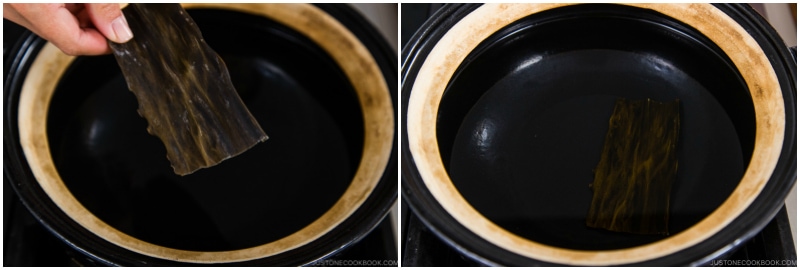
- Remove the heads and guts of ¾ cup iriko/niboshi (boiled and dried anchovies) and discard. If you’re not sure where the gut is, it’s the black area inside the belly. This will reduce the bitter flavor in the dashi.
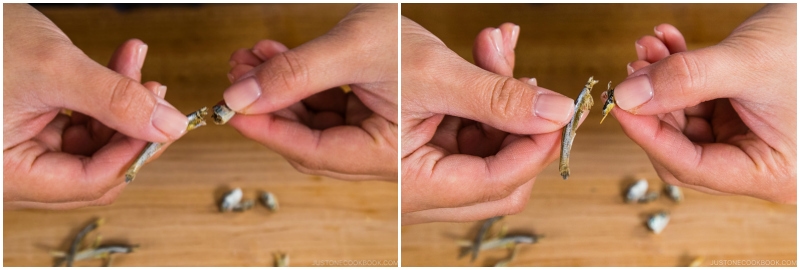
- Put the cleaned anchovies (the left pile in the image) in a tea bag or cheesecloth.
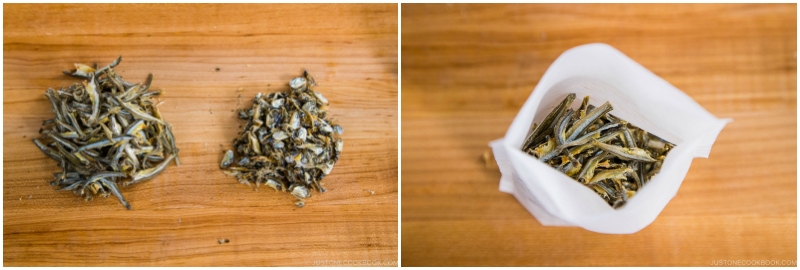
- Add the bag to the water and kombu, cover, and slowly bring it to a near boil on low heat.
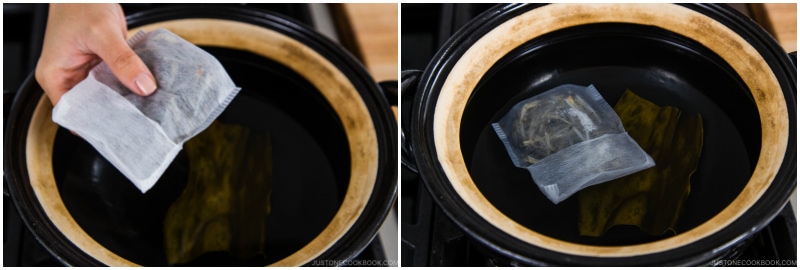
- Once almost boiling, remove the kombu and continue to cook the anchovies for another 10 minutes. Skim off the foam and scum from the stock while cooking. After 10 minutes, remove the bag of anchovies. Set aside.

To Prepare the Ingredients
- Remove the seeds of ⅛ kabocha squash and cut it into 1-inch cubes.

- Peel and cut 4.2 oz daikon radish into half lengthwise and cut into half-moon slices ¼ inch thick. Then, cut them in half to make quarter circles.

- Cut ⅓ carrot into rounds ¼ inch thick. If you‘d like, you can cut the rounds into a flower shape (hanagiri).
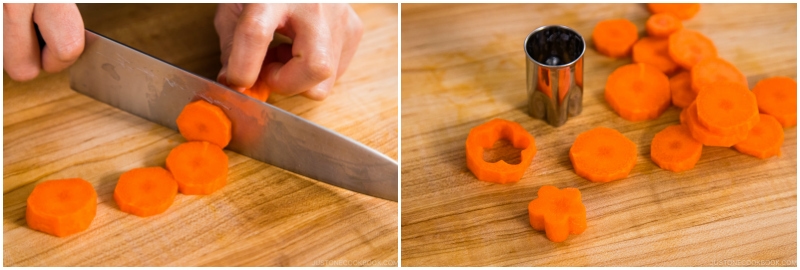
- Cut 1 Yukon gold potato into small chunks and cut ¼ onion lengthwise into ½-inch slices.
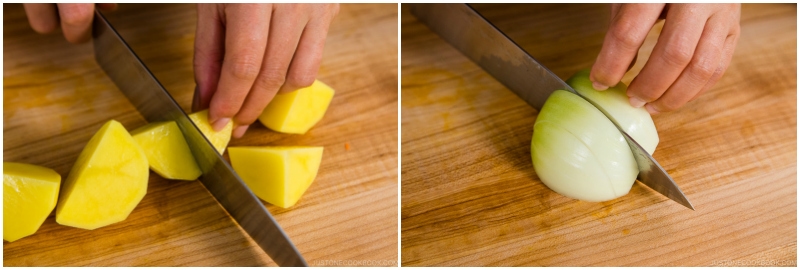
- Cut 2 leaves napa cabbage into smaller pieces, especially the bottom tougher part of the leaves.

- Cut ½ leek into 2-inch pieces. Cut each tube piece into quarters lengthwise.
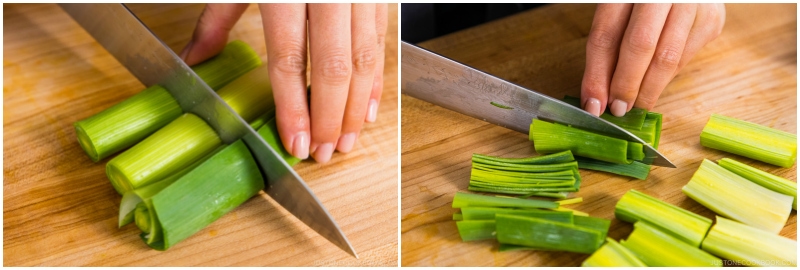
- Cut off the bottom of ½ package shimeji (brown beech) mushrooms and 2 shiitake mushrooms.
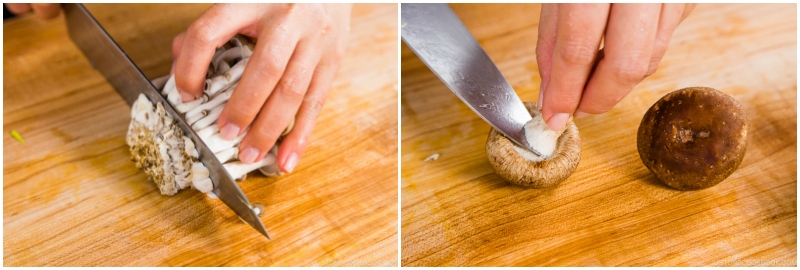
- [Optional] You cut a decorative flower shape on the caps of the shiitake mushrooms called shiitake hanagiri.

- Pour boiling water over 1 aburaage (deep-fried tofu pouch) to remove the oil. Cut it into 4 pieces.
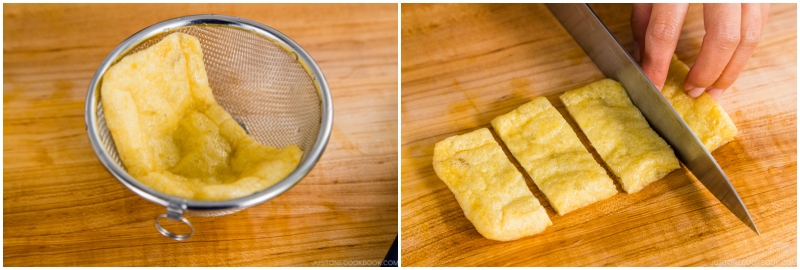
- Now, all the ingredients are ready to cook.

To Cook the Hoto
- Heat the dashi over medium heat. Start cooking the tough vegetables first, such as the leeks, onion, daikon, bottom white part of the napa cabbage, potatoes, kabocha, and so on.
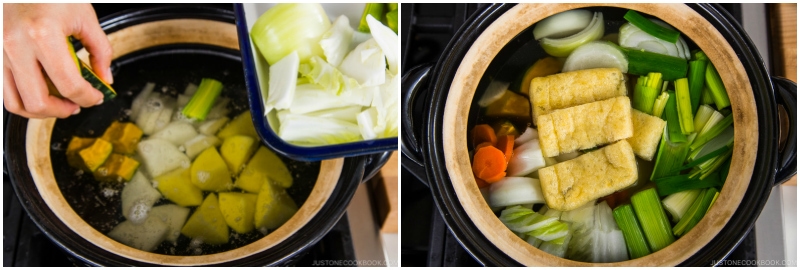
- Once boiling, add 6 oz sliced pork loin (separate each slice).

- Add 4 Tbsp sake and 2 Tbsp mirin. Bring it to boil. Once boiling, add the rest of the ingredients and 7.8 oz hoto noodles (uncooked).
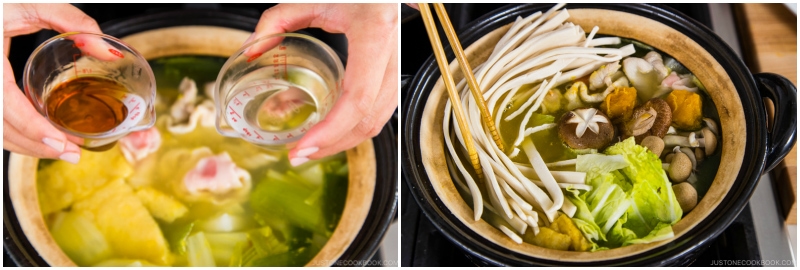
- Bring it back to a boil again and skim off the foam/scum as you cook.
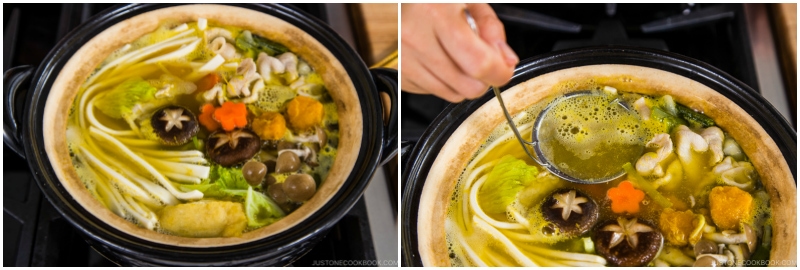
- Add 5 Tbsp miso (varies depending on the type of miso) and continue to cook on simmer until the noodles and all the ingredients are cooked through, about 10–15 minutes.
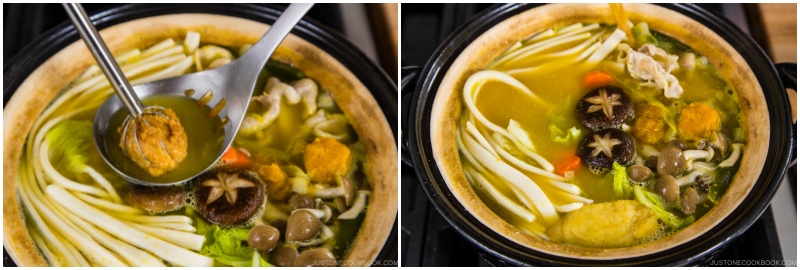
- Always check the flavor. Add Diamond Crystal kosher salt to taste and add more miso if necessary. Serve hot and enjoy! We usually bring the donabe to the table with a portable gas burner stove and serve into individual bowls. Sprinkle with shichimi togarashi (Japanese seven spice) if you like it spicy.
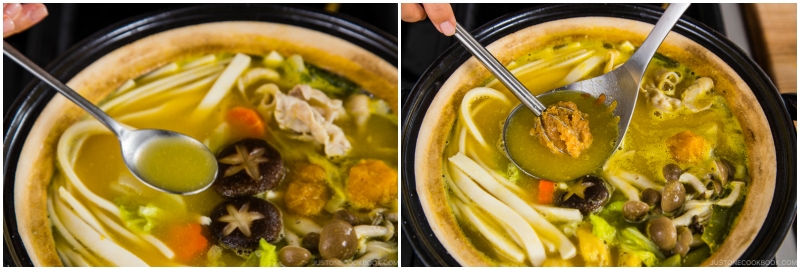
Notes
- In a large bowl, combine 200 g all-purpose flour and 90 g water. Only if necessary, add a little bit of water. Transfer to a working surface.
- Knead until the dough becomes smooth texture and form a ball. Transfer back to the bowl and cover with plastic wrap for 10 minutes.
- Sprinkle the working surface with the extra flour and divide the dough into 2. Flatten each dough with the heel of your hand and roll out the dough using a rolling pin. The thickness should be 3-4 mm.
- Sprinkle flour on the working surface and fold the sheet of the dough into thirds or fourths and cut into 1 cm thickness.
- Divide the noodles into 2 (one half for this recipe, the other half for the next batch of hoto – make sure to sprinkle extra flour so noodles don’t stick together).
Nutrition
Did you make this recipe?
Tag @justonecookbook on Instagram so we can see your delicious creation!


